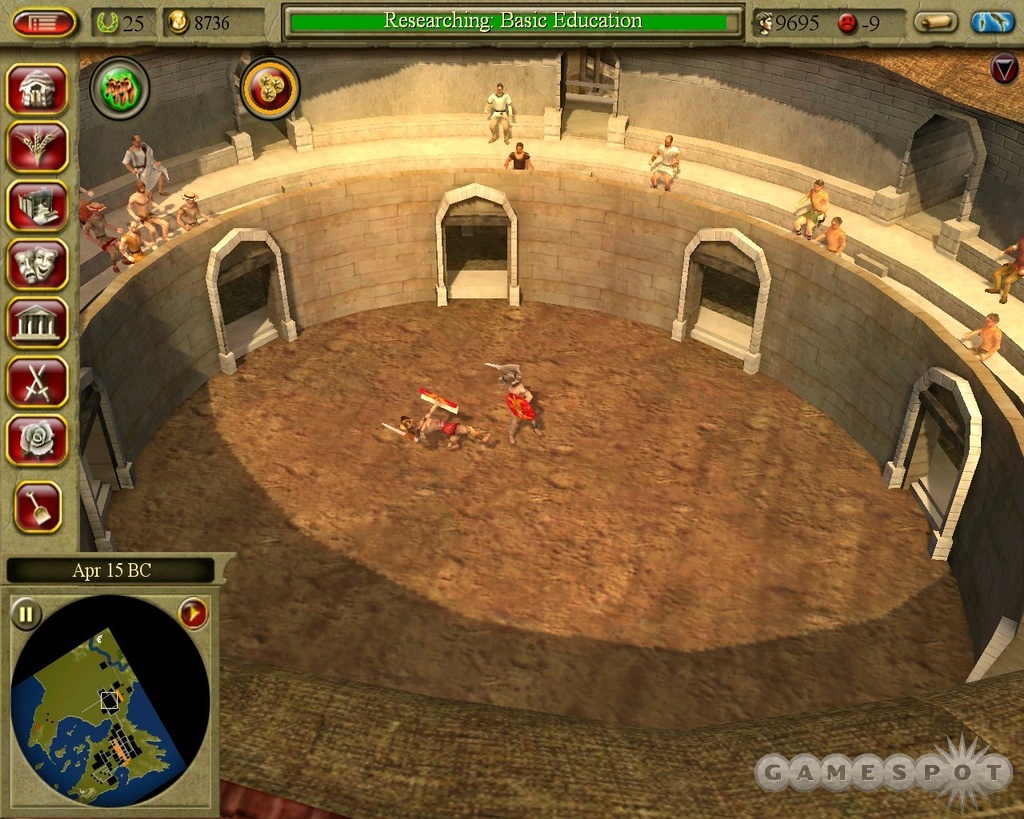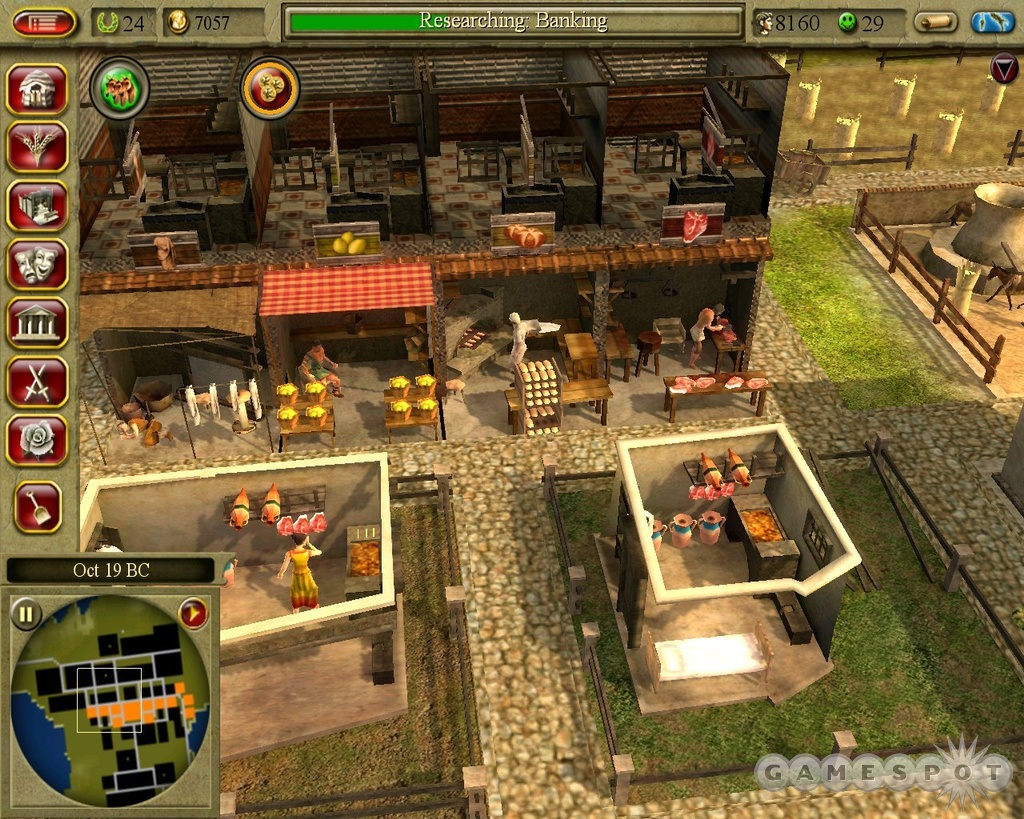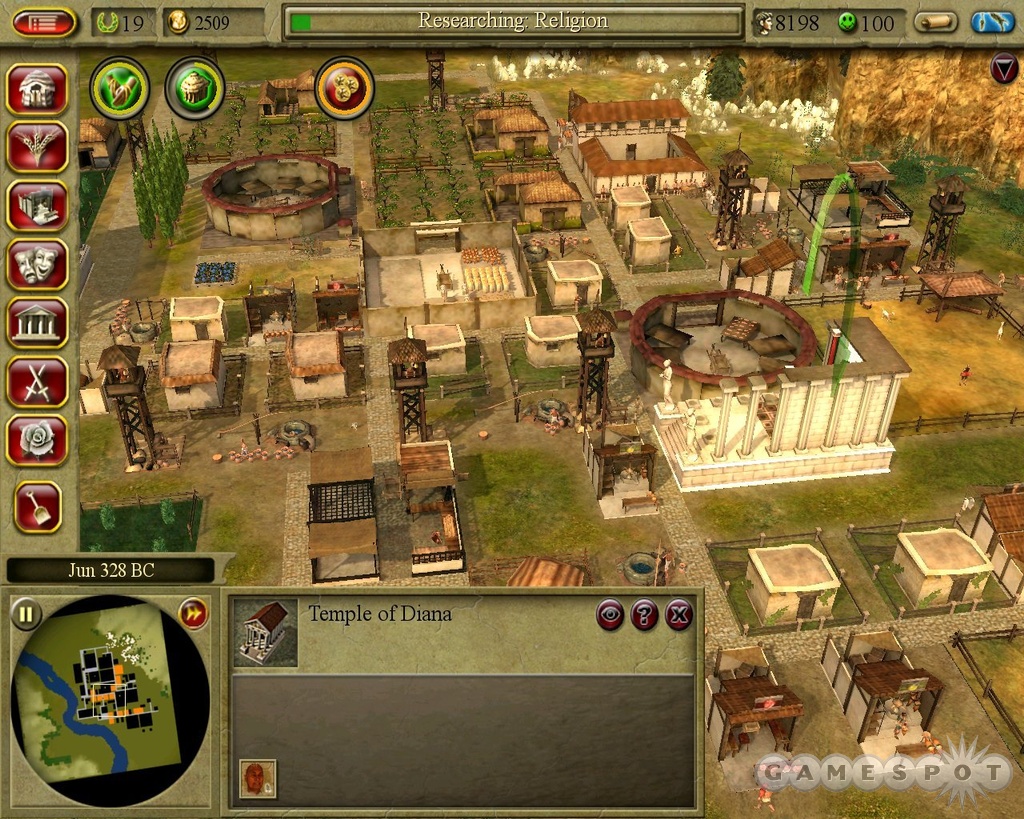Despite the name, CivCity: Rome isn't the next game in the Civilization franchise. While the two share part of a title and a publisher, Civilization IV was developed by Firaxis in the tradition of the classic game pioneered by industry legend Sid Meier, and this city builder was produced by Firefly Studios, a Hartford-based company best known for the cult 2001 hit Stronghold and its two sequels. So this is more of a traditional historical city builder than a toga-centric take on cultural victories, bobblehead leaders, and all of the other iconic aspects that have made Civilization one of the best-loved strategy series of all time.

CivCity: Rome grafts a simplified tech tree and a handful of wonders onto a clone of Impressions Games city builders from the late 1990s like Caesar and Pharaoh. Gameplay, visuals, and a succession of dreary mission goals evoke a been there, done that atmosphere. The historical ambience is impressive at times, but only city-building diehards and classicists will get much enjoyment out of building Rome, even if it really does take just a day in this case.
The look and feel of the game is very similar to Caesar III. The solo-only gameplay features both a small selection of one-off missions along with a fairly lengthy campaign in which you play a freelance governor taking assignments in cities across the empire. Missions in both modes of play generally aren't all that captivating. You basically build the same town over and over again, constructing shacks, olive farms, butcher shops, warehouses, baths, gladiatorial schools, theaters, and the like. Then you meet spectacularly lackluster goals like developing a set number of houses, selling a set amount of wine, quarrying a set amount of marble, building a set number of bathhouses, staging a set number of chariot races, and so forth.
Some missions force you to set up watchtowers to battle wildfires, and later even build forts and arm soldiers to battle barbarians, but for the most part you establish an economic system so that you can meet one set of numerical goals after another. This is pretty straightforward. There are no negative effects to worry about, as businesses don't have any negative effects, and there are just a couple of steps in the chains that take items from raw resources to finished goods. Basically, you locate or develop a resource, then process and sell it. Wheat, for example, is harvested on farms, then turned into flour in mills, which is then made into bread and sold to hungry citizens in bakeries. Wood is cut at a lumber camp and then carved into recliners and beds and sold to the plebs in carpentry shops. Fish is caught by fishermen, then filleted and sold at the fishmonger's stall. Sometimes you need to set up trade routes to buy and sell merchandise from other towns, but this is even simpler to manage (although it will try your patience, as mule trains take forever to go from one town to another, even with the game speed on its fastest setting) than producing the goods yourself.
Of course, the end goal is to give residents access to these products, plus other amenities like wells, barbers, taverns, temples, and the like, so that towns will eventually grow from a collection of humble shacks to majestic villas and you will become a god of Roman urban planning. But even though this is a tried-and-true system sported by city-building games for going on a decade now, CivCity: Rome is awfully clunky due to some irritating issues with both the visuals and the interface.
For starters, the game is ugly. Although it is nifty how roofs peel back to show you citizens going about their daily lives (this also provides tips during play, as you can visually check how wheat is being stockpiled, if olive presses have enough olives, and so forth), and how clicking on homes and businesses create arrows connecting them to their wandering citizens, the jagged visuals are three years out of date. They're also hampered by huge info screens that block off much of the city, a camera angle that makes it impossible to look at cities from anything even approximating a top-down view, and a bug that prevents you from selecting citizens and buildings by clicking directly on them in 1280x1024 resolution (you have to offset the cursor about an inch below and to the right of the object that you're trying to grab, which makes it tough to access buildings in crowded cities and flat-out impossible to select citizens or demolish anything smaller than a house).

Some houses don't seem to be able to access specific resources, even when they are well within their area of effect and nicely hooked up with roads. Sometimes you have to blitz an area with certain types of buildings, going so far as to build a temple on somebody's front doorstep before the residents clue into the fact that they really do have access to the facilities they need to upgrade their hovels. Buildings ignoring resources is a problem that has plagued city-building games off and on for a long time now, so it is still disappointing to see that Firefly didn't completely get rid of this issue here.
Resources are collected and processed in different ways, too, with varying numbers of workers needed to man farms and stores, although the game never clues you in to this fact or even bothers to note how many employees it takes to fully stock each facility. While the advisor drones on about the declining amount of food in granaries or happiness declining, he never gives tips on key game issues relating to scenario objectives and you're left to discover the differences between goods production on your own. This can be troublesome, as it's a matter of trial and error to determine how many wineries can be supported by each vineyard, how many butcher shops can be supported by each goat farm, and so forth. You tend to swing through economic booms and busts in every scenario, going from bursting your granaries at the seams with too many farms and shops cranking out food, to not having enough and experiencing a depression in which food stocks dwindle and people start leaving town for greener pastures.
A couple of aspects of CivCity: Rome elevate the game somewhat. The historical flavor is very nicely handled; Ancient Rome is well represented by figures from history, gods, archetypes like baths and coliseums, esoteric frills like chariot races and multiple types of gladiatorial schools, and even a representation of the class system of the time with separate types of homes and goods for the rich and poor (the well-off need geese to eat and recliners for their villas; the poor make do with goat meat and simple beds).
Architecture is pretty much dead on, and citizens provide cute, semihistorical one-liners when you click on them, like "Pizza--now there's one idea that will never catch on" (although it would be better if citizens would ditch the jokes and more frequently tell you what is actually going on in the city). There are a lot of liberties taken with the timeline, though, as you constantly get served a mish-mash of messages and events from around a thousand years of history. Getting a video message from Hadrian 600 years before his birth doesn't enhance the game's historical feel. But overall, the game still evokes ancient Rome in an acceptably "gamey" way.
Aspects of Civilization grafted onto the old-fashioned, stereotypical city building also liven things up. There is a tech tree of advancements to research, although it is tiny in comparison to what is on offer in Civ IV. Specific techs don't provide much in the way of wide-ranging bonuses, either. Each tech basically gives a bump to a single attribute. Mysticism, for instance, provides a temporary 10 percent boost to city happiness. Coinage cranks up tax collecting by 20 percent. Books enlarge libraries and schools. Many techs can also be researched quickly, so you can tear through a pile of them in the course of a scenario.

The version of the Civlopedia included here is similarly half-baked. Entries are explained with short, bullet-point blurbs that wouldn't have been out of place in a kid's game. Wonders are similarly trimmed down. It's good to have them in the game, and it's even better that they include historical Roman accomplishments like the Colosseum, the Pharos Lighthouse, the Pantheon, and the Library of Alexandria, but all they do is boost prestige and citizen happiness. There are just seven of them in the game, too, which seems skimpy considering how much Rome built over the centuries.
CivCity: Rome could have been so much more. Civ-styled tech trees, units, diplomacy, and great people could have provided a shot in the arm to the city-building genre, which hasn't evolved in any significant way since Impressions set the standard almost a decade ago. Classical history buffs should find it interesting for a short time because of the historical flavor, but déjà vu quickly overwhelms any sense of enjoyment from trying to match Augustus and turn Rome from brick into marble.